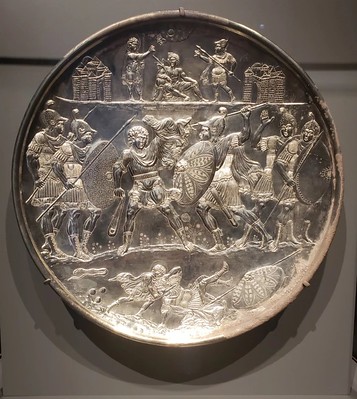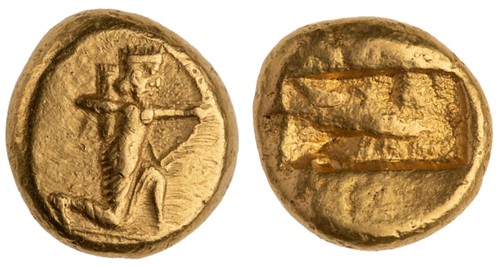
PREV ARTICLE
NEXT ARTICLE
FULL ISSUE
PREV FULL ISSUE
V25 2022 INDEX E-SYLUM ARCHIVE GETTY PERSIA EXHIBITThis Los Angeles Times review of a new exhibit at the Getty includes coins and medals on loan from the American Numismatic Society. -Editor
What propaganda used to be is on glamorous display in an exquisitely crafted silver plate that anchors the final room of David is a stand-in for Heraclius, the relentlessly warring Roman sovereign. Goliath is the bigger, older, more powerful representative of Persia, established for a thousand years. At the top, the two agree to fight as a bemused river god looks on. In the center, the widest of the three registers, the bout has begun. Goliath has his spear and big shield raised, while David has loaded his slingshot and is waving a distracting cloak in his opponent's face. How things might go from here is suggested by the soldiers arrayed behind the two combatants: David's duo stand upright and firm, Goliath's are turning and lean away, ready to bolt. In the bottom register comes the dénouement: David hacks off tumbling Goliath's head, presumably with his own sword. Framing them, the giant's big pile of scattered weapons at the right dwarfs the winner's little sling and three small rocks at the left. The exhibition's fine catalog, prepared by Getty director Timothy Potts and curators Jeffrey Spier and Sara E. Coles, draws a notable historical conclusion. Heraclius, in his bloody Byzantine victory over Persia, is thought to have beheaded the Sasanian commander. That would make the silver plate a pretty specific allegory for the Eastern Roman emperor as God's designated champion on earth, like David, the victorious underdog in the struggle against the Philistine giant. The show is divided into three sections, each focused on a different Persian empire. The Achaemenid (550-330 BC), founded by Cyrus the Great and expanded by Darius I, kicked things off and grew to encompass 2 million square miles — all the way from the Balkans to the Indus Valley. It was the largest empire ever, until Greece's Alexander the Great arrived with his armies and busted things up. Impressive loans have come from the Louvre in Paris, the British Museum in London, the Oriental Institute in Chicago and elsewhere. The David and Goliath plate is from New York's Metropolitan Museum of Art. Lions and bulls were featured on early Achaemenid coins, but a small gold disk announces a shift: A kneeling archer is the figure of Darius I, whose likeness on the chunky little coin asserts his position as the source of ultimate power. The tiny coin is just over a half-inch wide — 8.36 grams of gold, worth about $500 today — and it's but one of dozens of coins, seals and carved gemstones in the show. They're small but fascinating, stylistically changing records of dynasties, rulers, events and timetables of history. Scholars use them to identify all manner of things, like portraits of luminaries and festivals. The Getty has installed touchpads adjacent to each display of groups of them, which lets a viewer examine the object in closeup and access more information.
To read the complete article, see:
Wayne Homren, Editor The Numismatic Bibliomania Society is a non-profit organization promoting numismatic literature. See our web site at coinbooks.org. To submit items for publication in The E-Sylum, write to the Editor at this address: whomren@gmail.com To subscribe go to: https://my.binhost.com/lists/listinfo/esylum All Rights Reserved. NBS Home Page Contact the NBS webmaster 
|


